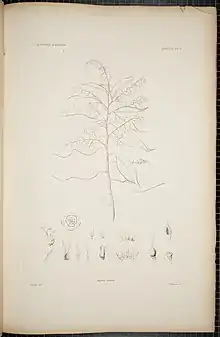Agatea
Agatea is a genus of flowering plants in the violet family Violaceae, with seven accepted species, found in New Guinea and New Caledonia.
| Agatea | |
|---|---|
 | |
| Agatea violaris | |
| Scientific classification | |
| Kingdom: | Plantae |
| Clade: | Tracheophytes |
| Clade: | Angiosperms |
| Clade: | Eudicots |
| Clade: | Rosids |
| Order: | Malpighiales |
| Family: | Violaceae |
| Subfamily: | Violoideae |
| Tribe: | Violeae |
| Genus: | Agatea A.Gray[1][2][3] |
| Type species | |
| Agatea violaris A.Gray[4] | |
| Species | |
| |
| Synonyms[2] | |
Description
Lianas or reclining shrubs with lanceolate to ovate leaves. The flowers are in terminal pseudo-racemes or racemoids, with white corollas that are strongly zygomorphic (bilaterally symmetrical) with the very large bottom petal differentiated into a claw and blade and saccate (pouch like) at the base. On the five stamens, the filaments are weakly connate with the two lowest anthers weakly calcarate (spurred) and possessing a large dorsal connective appendage that is entire and oblong-ovate. In the gynoecium, the style is filiform (threadlike) to clavate (club like). The fruit is a thin to thick-walled capsule with 3 or 6 valves. There are two seeds per carpel, that are strongly flattened and encircled with a broad thin wing. The chromosome number is 2n=16.[5][6][7]
Taxonomy
The genus Agatea was first described by Gray in 1852,[8] following the United States Exploring Expedition of 1838–1842, and therefore bears his name, A.Gray, as the botanical authority.[4] Gray's description was of the single species, Agatea violaris, which is thus the type species. His report was published in full in 1854.[9]
Early taxonomic schemes such as Bentham and Hooker (1862)[10] placed Agatea within subfamily Violoideae, tribe Violeae, subtribe Violinae.[6][11] For a while, the name Agatea was disputed, and Agation used instead, but this was resolved in favor of the former name.[12] The genus has also been subject to over-description resulting from polymorphism.
Agatea is one of four lianescent genera in Violaceae, together with Calyptrion Ging., Anchietea A.St.-Hil. and the more recently discovered (2003) Hybanthopsis Paula-Souza.[13] In earlier classifications primarily based on floral morphology these were distributed among separate subtribes, but molecular phylogenetic studies has now grouped them together into a single lianescent clade, one of four within the family. Earlier schemes had placed Agatea within subfamily Violoideae, tribe Violeae, subtribe Hybanthinae, with Hybanthopsis but Calyptrion and Anchietea in subtribe Violinae.[5][11]
Etymology
The genus is named for the botanical draughtsman on the expedition, Alfred T. Agate.[8]
Species
Although estimates of the number of species has varied between one[12] and ten,[7] there are seven generally accepted species.[14][2]
- Agatea lecointei Munzinger[12]
- Agatea longipedicellata (Bakerf.) Guillaumin & Thorne[15]
- Agatea macrobotrys K.Schum. & Lauterb.
- Agatea rufotomentosa (Baker f.) Munzinger
- Agatea schlechteri Melch.
- Agatea veillonii Munzinger[12][15]
- Agatea violaris A.Gray Type
New species, eg A. lecointei and A. veillonii, continue to be discovered, these two in New Caledonia in 2001.[12] Some authors also include:[1]
Distribution and habitat
Agatea are native to New Guinea and some nearby South Pacific islands including New Caledonia, and are found in monsoon forests.[5][2]
References
Bibliography
- Books
- Ballard, Harvey E; Paula-Souza, Juliana de; Wahlert, Gregory A (2013). "Violaceae". In Kubitzki, Klaus (ed.). Flowering Plants. 11 Eudicots: Malpighiales. Springer Science & Business Media. pp. 303–322. ISBN 978-3-642-39417-1.(Also preview at Springer)
- Bentham, G.; Hooker, J.D. (1862). "Violarieae". Genera plantarum ad exemplaria imprimis in herbariis kewensibus servata definita (3 vols.). 1(1). London: L Reeve & Co. pp. 114–121.CS1 maint: ref=harv (link)
- Byng, James W. (2014). "Violaceae". The Flowering Plants Handbook: A practical guide to families and genera of the world. Plant Gateway Ltd. pp. 238–239. ISBN 978-0-9929993-1-5.CS1 maint: ref=harv (link)
- Christenhusz, Maarten J. M.; Fay, Michael F.; Chase, Mark W. (2017). "Violaceae". Plants of the World: An Illustrated Encyclopedia of Vascular Plants. University of Chicago Press. pp. 324–325. ISBN 978-0-226-52292-0.
- Gray, Asa (1854). United States Exploring Expedition Botany. During the years 1838, 1839, 1840, 1841, 1842. Under the command of Charles Wilkes, U.S.N. Vol. XV. Botany. Phanerogamia, Part 1: With a Folio Atlas of One Hundred Plates. Philadelphia: C Sherman.
- Articles
- Gray, Asa (4 May 1852). "Agatea Nov. Gen.". Proceedings of the American Academy of Arts and Sciences. 2: 323–324.
- Munzinger, Jérôme (September 2001). "Two new species of Agatea (Violaceae) endemic to New Caledonia, with some taxonomic notes and a key to New Caledonian species". Botanical Journal of the Linnean Society. 137 (1): 91–97. doi:10.1111/j.1095-8339.2001.tb01110.x.
- de Paula-Souza, Juliana; Pirani, José Rubens (22 December 2014). "Reestablishment of Calyptrion (Violaceae)". Taxon. 63 (6): 1335–1339. doi:10.12705/636.7.CS1 maint: ref=harv (link)
- de Paula-Souza, Juliana; Souza, Vinicius Castro (July 2003). "Hybanthopsis, a new genus of Violaceae from Eastern Brazil". Brittonia. 55 (3): 209–213. doi:10.1663/0007-196X(2003)055[0209:HANGOV]2.0.CO;2.
- Wahlert, Gregory A.; Marcussen, Thomas; de Paula-Souza, Juliana; Feng, Min; Ballard, Harvey E. (1 March 2014). "A Phylogeny of the Violaceae (Malpighiales) Inferred from Plastid DNA Sequences: Implications for Generic Diversity and Intrafamilial Classification". Systematic Botany. 39 (1): 239–252. doi:10.1600/036364414X678008.
- Websites
- WFO (2019). "Agatea A. Gray Proc. Amer. Acad. Arts 2: 323. 1852". World Flora Online. Retrieved 11 April 2020.CS1 maint: ref=harv (link)
- POTWO. "Agatea A.Gray". Plants of the World Online. Royal Botanic Gardens, Kew. Retrieved 5 May 2020.
- IPNI. "Agatea A.Gray, Proc. Amer. Acad. Arts ii. (1852) 323". Royal Botanic Gardens, Kew. Retrieved 13 April 2020.
- "Agatea A. Gray". Tropicos. Missouri Botanical Garden. 2020. Retrieved 16 April 2020.
- INPN (2020). "Agatea". Inventaire National du Patrimoine Naturel. Muséum national d’Histoire naturelle. Retrieved 11 May 2020.CS1 maint: ref=harv (link)